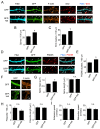Myosin X and its motorless isoform differentially modulate dendritic spine development by regulating trafficking and retention of vasodilator-stimulated phosphoprotein
- PMID: 23943878
- PMCID: PMC3795341
- DOI: 10.1242/jcs.132969
Myosin X and its motorless isoform differentially modulate dendritic spine development by regulating trafficking and retention of vasodilator-stimulated phosphoprotein
Abstract
Myosin X (Myo10) is an unconventional myosin with two known isoforms: full-length (FL)-Myo10 that has motor activity, and a recently identified brain-expressed isoform, headless (Hdl)-Myo10, which lacks most of the motor domain. FL-Myo10 is involved in the regulation of filopodia formation in non-neuronal cells; however, the biological function of Hdl-Myo10 remains largely unknown. Here, we show that FL- and Hdl-Myo10 have important, but distinct, roles in the development of dendritic spines and synapses in hippocampal neurons. FL-Myo10 induces formation of dendritic filopodia and modulates filopodia dynamics by trafficking the actin-binding protein vasodilator-stimulated phosphoprotein (VASP) to the tips of filopodia. By contrast, Hdl-Myo10 acts on dendritic spines to enhance spine and synaptic density as well as spine head expansion by increasing the retention of VASP in spines. Thus, this study demonstrates a novel biological function for Hdl-Myo10 and an important new role for both Myo10 isoforms in the development of dendritic spines and synapses.
Keywords: Dendritic spine; Filopodia; Hippocampal neuron; Myosin; Synapse.
Figures







References
-
- Almagro S., Durmort C., Chervin-Pétinot A., Heyraud S., Dubois M., Lambert O., Maillefaud C., Hewat E., Schaal J. P., Huber P. et al.(2010). The motor protein myosin-X transports VE-cadherin along filopodia to allow the formation of early endothelial cell-cell contacts. Mol. Cell. Biol. 30, 1703–1717 10.1128/MCB.01226-09 - DOI - PMC - PubMed
-
- Berg J. S., Derfler B. H., Pennisi C. M., Corey D. P., Cheney R. E. (2000). Myosin-X, a novel myosin with pleckstrin homology domains, associates with regions of dynamic actin. J. Cell Sci. 113, 3439–3451 - PubMed
Publication types
MeSH terms
Substances
Grants and funding
LinkOut - more resources
Full Text Sources
Other Literature Sources
Molecular Biology Databases

